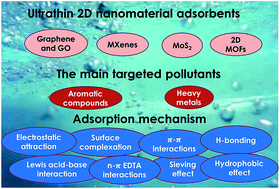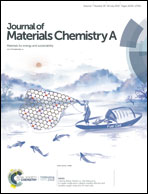A new paradigm of ultrathin 2D nanomaterial adsorbents in aqueous media: graphene and GO, MoS2, MXenes, and 2D MOFs
Abstract
Adsorption is a facile, effective, and economical method for capturing contaminants from aqueous solutions. In a sharp contrast to traditional adsorbent materials, ultrathin two-dimensional (2D) nanomaterials are a new emerging class of high-performance adsorbents owing to their high surface area, atomic-level thickness, and abundant exposed active sites. This review focuses on the recent progresses made in four representative 2D nanomaterials (namely, graphene and GO, MoS2, MXenes, and MOFs) as superior adsorbents for the removal of toxic ions and organic contaminants from aquatic environments. Initially, the advances in the syntheses, structures, and chemical properties are described. Thereafter, the adsorption properties of 2D nanomaterials toward various pollutants are assessed and compared with those of other adsorbents. In particular, the adsorption mechanisms are systematically summarized on the basis of experimental and theoretical studies. In the end, current challenges and future research needs that are to be addressed are briefly discussed.

- This article is part of the themed collection: Recent Review Articles


 Please wait while we load your content...
Please wait while we load your content...